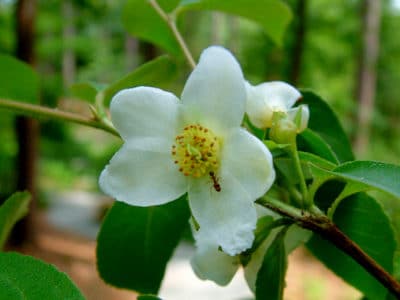Polk County’s Most Wanted – Mountain Camellia
Have you seen Mountain Camellia?
In a joint effort to expand the knowledge and understanding of the flora and fauna of Polk County, Conserving Carolina and botanist/ecologist David Campbell need your help in locating this month’s “Polk County’s Most Wanted—Plant,” Mountain Camellia (Stewartia ovata), one of the Southeast’s most beautiful shrubs.
How do I identify Mountain Camellia?
Mountain Camellia is a deciduous shrub reaching a height of over fifteen feet, Leaves are up to six inches in length, ovate, alternate, simple, and weakly serrate with ciliate (‘haired’) margins. Flowers are large and spectacular, up to three inches wide, with five white petals. The flower petal edges are somewhat crimped and scalloped. Flowers also have conspicuously yellow anthers.
Where should I look for Mountain Camellia?
Flowering occurs from June through July, Mountain Camellia occurs primarily in the mountains and piedmont region of the southern Appalachians. It favors acidic soils on bluffs and slopes, often near creeks or rivers, and it frequently grows in openings with Rosebay Rhododendron (Rhododendron maximum).
Search for this plant on well-drained slopes dominated by Rhododendron, particularly where there are gaps in the Rhododendron thicket that allow higher levels of sunlight. Eastern Polk County is more likely to have the acidic soil types favored by Mountain Camellia, but it is conceivable that it could occur throughout the county in areas of appropriate habitat.
Mountain Camellia is an uncommon to rare shrub throughout its range and discovering one in the wild in full flower is a sight not soon to be forgotten. Mountain Camellia has been found in neighboring the counties of Burke and Rutherford, but thus far has evaded attempts to locate it in Polk.
What can you do?
If you think that you have seen Mountain Camellia in Polk County, please contact Pam Torlina at Conserving Carolina by email at [email protected].
For More Information
See more about “Polk County’s Most Wanted.” Download and print a “Pocket Guide” with all of the “Most Wanted” plants, animals, and habitats that you can be on the lookout for when you’re out in the field!
A Biological Inventory of Polk County
Now available for download: “An Inventory of the Significant Natural Areas of Polk County, North Carolina,” a culmination of David Campbell’s seven years in the field documenting the rare and significant flora and fauna in Polk County.
